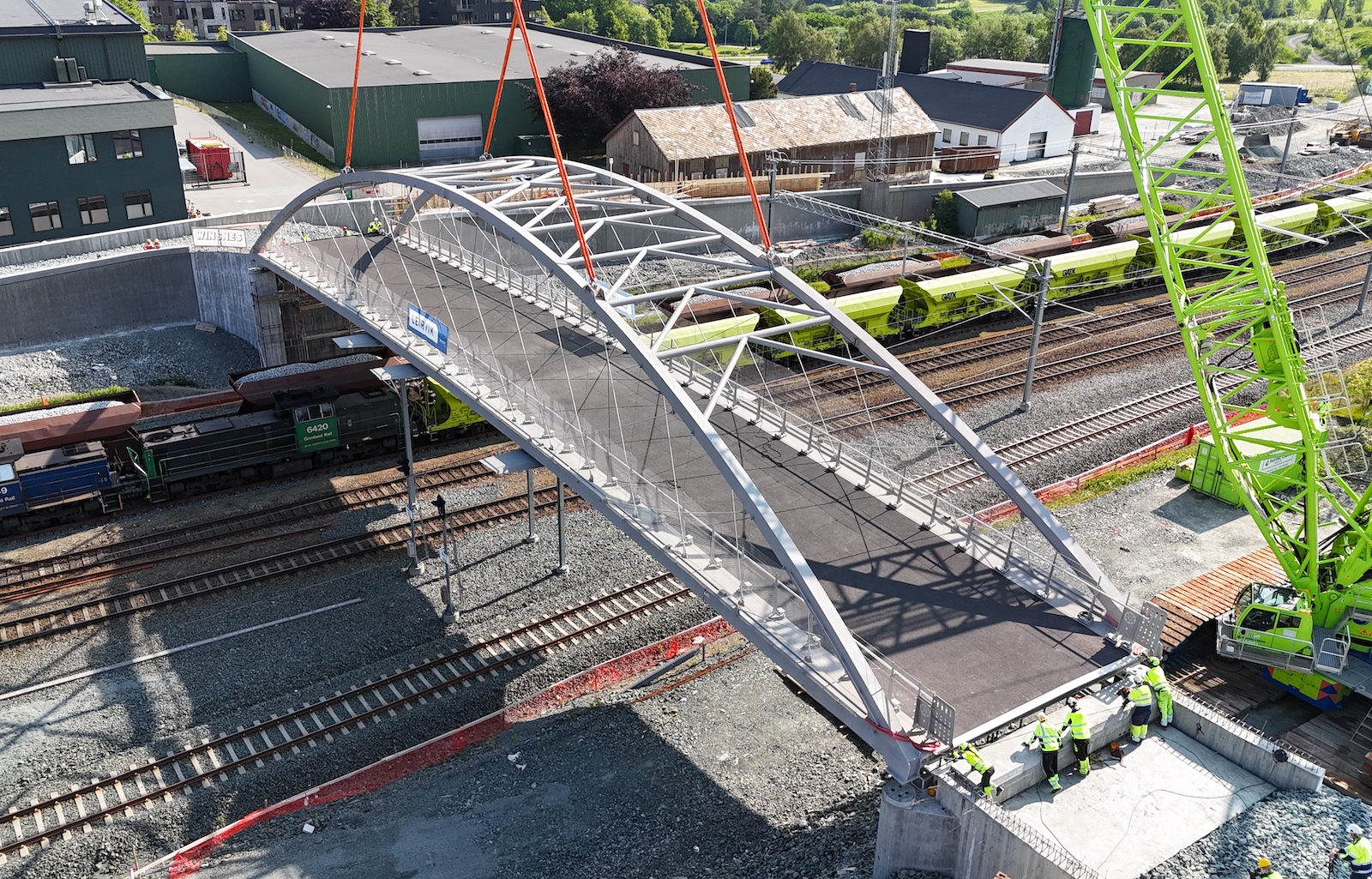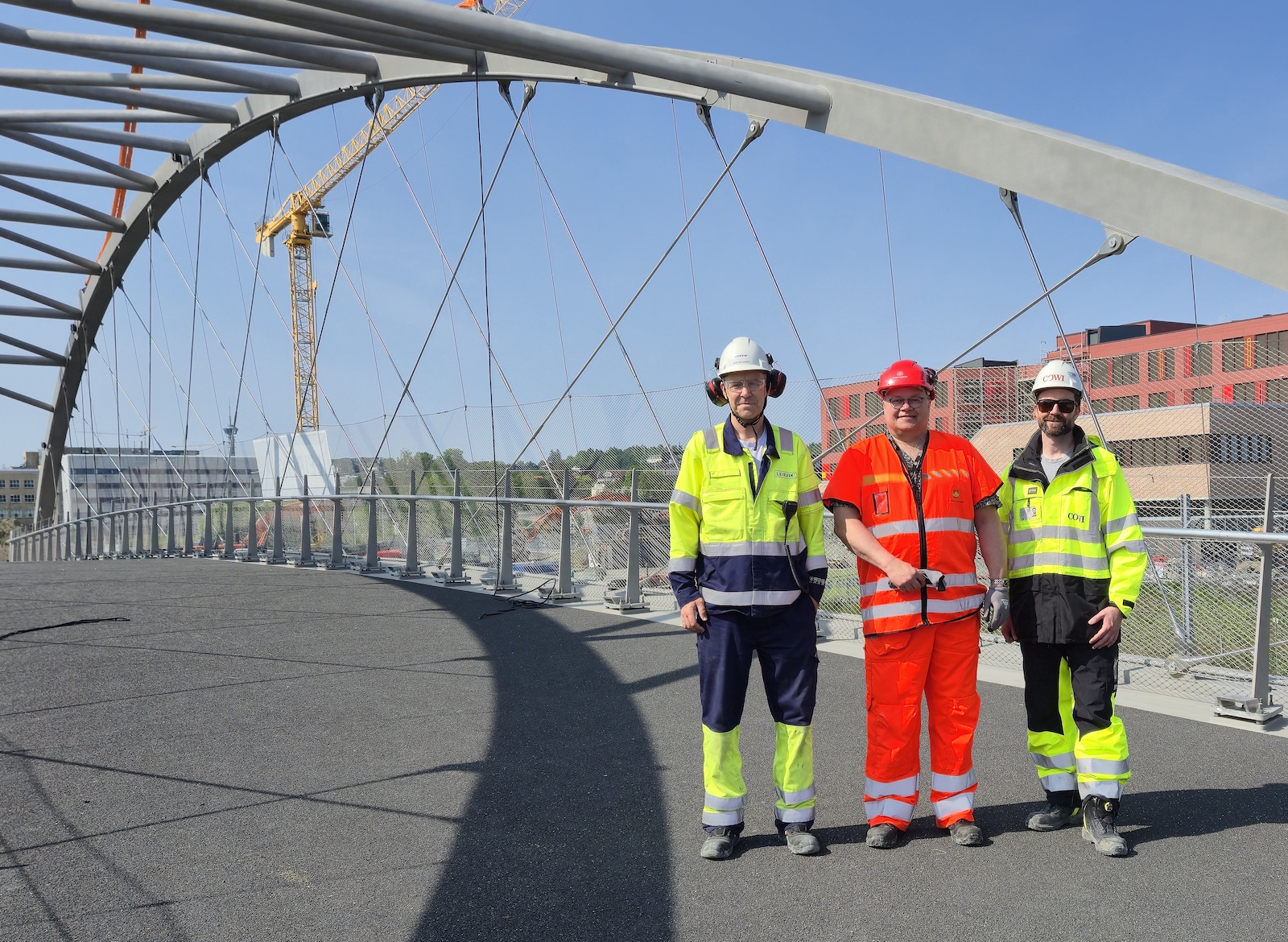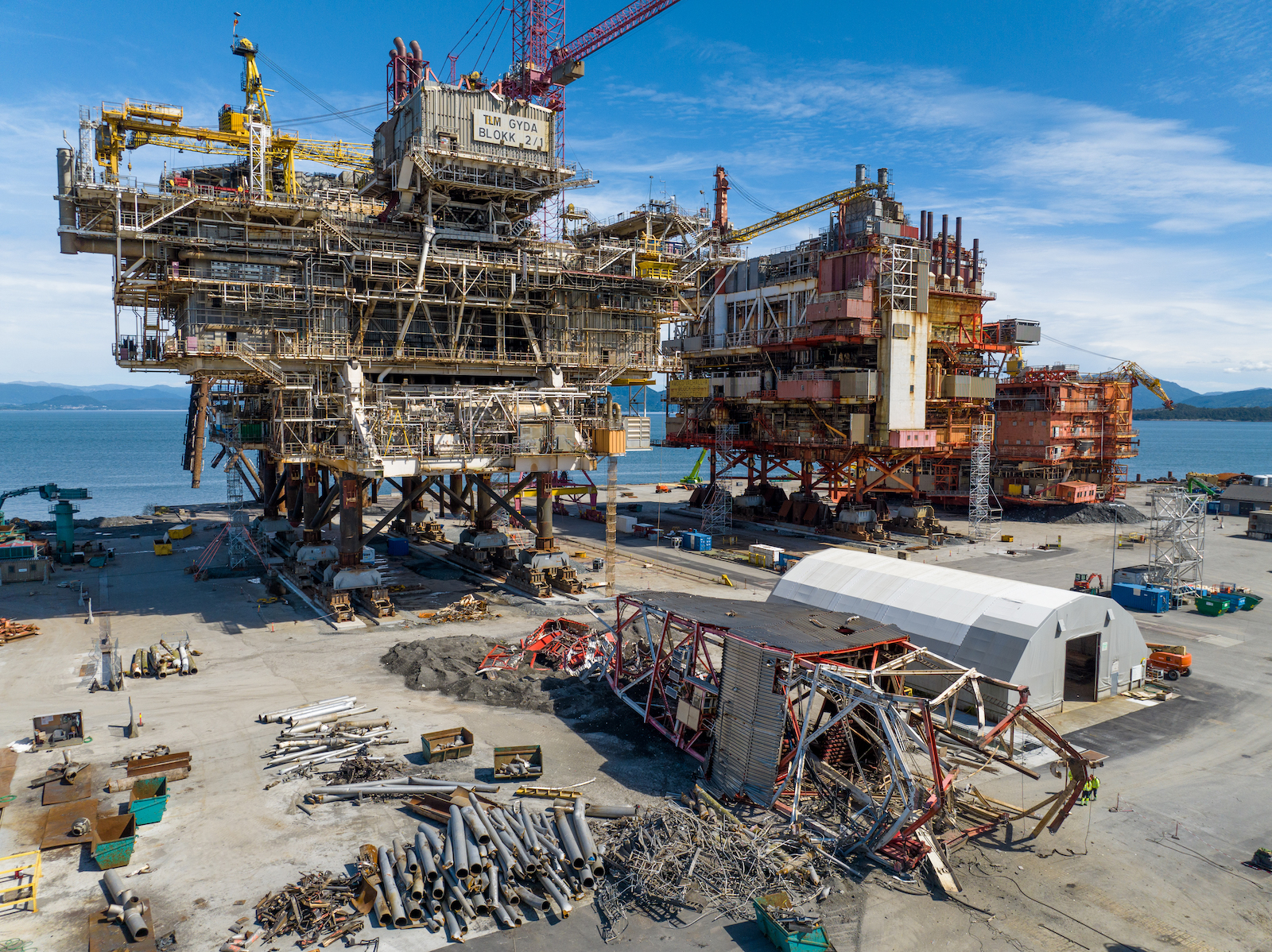By Kevin Widlic, Contributing Editor.
Hangarbrua, a pedestrian and cycle bridge built with aluminum from a decommissioned offshore oil platform, has been lifted into place in Trondheim, Norway, and will open this fall. The Norwegian Public Roads Administration expects the bridge to be maintenance free for 100 years, and a life cycle analysis shows that the use of aluminum has reduced significantly the amount of greenhouse gas emissions of the bridge compared to an alternative stainless-steel concept.
The Hangarbrua bridge, which crosses over the railway tracks at Leangen, is 55 m long and 9 m wide. With only one-third of the weight of the steel version of the bridge, the recycled-aluminum Hangarbrua weighs 60 tonnes and is classified as a light bridge. It is a network arch bridge constructed entirely from aluminum, with a bridge deck composed of recycled aluminum sourced from the decommissioned North Sea oil platform Gyda. In fact, the bridge’s all-aluminum network arch construction is the first of its kind in the world, consisting of 100% recycled aluminum. Only the tension rods are made from stainless steel.
Nordic Crane lifted the fully assembled bridge into place on June 19, using a 650-tonne crawler crane with a 72 m long boom (Figure 1). Prior to the lifting operation, the bridge had been transported to the location as separate parts in 21 truckloads, and was then assembled on-site at the Leangen railway station in Trondheim.

“The successful installation is the result of meticulous planning and precise execution,” said project manager Torstein Ryeng of the Norwegian Public Roads Administration.1 “A significant number of skilled engineers contributed tirelessly, and they deserve great recognition.”
Broad Collaboration
Hangarbrua is the first aluminum bridge constructed in Norway since the 1990s. The project, owned by the Norwegian Public Roads Administration, was developed through a partnership between Leirvik AS, Hydro, Aker Solutions, and Stena. Leirvik, the main contractor, designed and constructed the bridge in collaboration with COWI A/S, which handled the design and construction plan (Figure 2). Hydro, Aker Solutions, and Stena were responsible for providing the recycled bridge deck, with Hydro recycling the Gyda material and delivering the extruded aluminum products for the deck.

Following the test assembly of the bridge at Leirvik’s facility in Western Norway last December, the four main bridge segments were shipped to Trondheim three months later. Leirvik then welded the segments together while installing the suspension rods, railings, and safety nets on-site at Leangen.
“While we have extensive experience with aluminum structures (in the oil and gas sector), this is our first aluminum bridge in 30 years,” said Geir Mosaker, project manager at Leirvik, referring to the previous Forsmo Bridge that Leirvik delivered in 1995.
Environmental Analysis
COWI is an international consulting group headquartered in Denmark that specializes in engineering, architecture, energy, and environmental science. In addition to carrying out the design and construction plan for Hangarbrua, COWI was asked to provide a research and development analysis of the bridge’s greenhouse gas emissions, where the emissions for the aluminum bridge could be compared with the emissions from the same concept made in stainless steel.
The reasoning behind the analysis is that aluminum bridges are rare, even today, and Hangarbrua is unique in terms of its material choice. It is therefore considered a pilot project and, as such, is important with regard to the potential future use of aluminum in bridge construction.
“Aluminum is one of several functional bridge construction materials,” says Mosaker. “It can be used in most bridges, but it has its advantage when light weight and durability is challenging, for example, in projects with weak ground conditions, in harsh and coastal environments, with quick installation and easy lifting over highly dense roads or train lines. That it is lightweight, maintenance-free, and highly recyclable are its most significant advantages.”
Stainless Steel Alternative
As part of COWI’s assessment, both aluminum and stainless steel were compared for the project, which makes good sense. While engineers across the world have been building bridges with carbon steel for well over 100 years, today they are finding other materials in the mix, and the competition is high.
Once upon a time, bridge builders looked at stainless steel as a useful material for bridge components, such as guardrails and handrails, mainly due to its anti-corrosion properties—just like aluminum. Aesthetics also played a part in those decisions, because stainless steel, like aluminum, looks good.2
The material decisions have been changing, however, with the emergence of more tailored metals and alloy development. To illustrate: Durability and maintenance are critical points in bridges. With the properties now available, stainless steel and aluminum can both add to the longevity of the bridge structure and reduce the amount of maintenance required compared with carbon steel. A longer lifetime with lower costs? Yes.
As a result, since the turn of the century, more bridges have been utilizing these materials in their construction, starting with stainless steel. Austenitic and duplex stainless steels are the most widely used stainless steels for bridge components, mainly due to their good corrosion resistance and strength, particularly in duplex grades. Two years ago, the International Stainless Steel Forum (ISSF) published a report that listed 61 bridges made in stainless steel. One example is the deck for London’s Millennium Bridge. Another is the Harbor Drive Pedestrian Bridge in San Diego, which Stainless Steel World Americas claims may have been the first bridge in the country in which duplex stainless steel was applied.3
Besides durability and reduced maintenance, stainless steel also provides good corrosion resistance, a high strength-to-weight ratio, good aesthetics, and recyclability.4 On the flip side, stainless steel can have a higher initial cost compared to traditional carbon steel, and it can be heavier than alternative materials, such as aluminum, which would impact design considerations. Stainless steel has not been widely used in load-bearing structures. As the COWI report showed, the material also has higher life cycle emissions than aluminum.
Low-Carbon Aluminum
COWI’s report comprises a life cycle analysis (LCA) that includes the greenhouse gas emissions for Hangarbrua in both aluminum and stainless steel, based on the same network arch bridge concept. The LCA covers the phases for material production and the transportation of materials to the construction site, the use phase (referring to energy use during operation), and the end phase, which covers disposal of the construction waste.
COWI also included a separate analysis, which included Module D. This refers to any benefits/emission reductions and burdens resulting from the recycling and reuse of the materials after the end of their life. The results showed that the greenhouse gas emissions for the aluminum bridge over its life cycle are 120 tonnes CO2e with Module D included, and 420 tonnes CO2e without Module D. The corresponding numbers for the stainless steel bridge are 500 tonnes CO2e and 620 tonnes CO2e. In other words, the steel bridge showed four times more greenhouse gas emissions than the aluminum bridge when Module D is included, and about 50% more without.
The report goes on to explain the reasons for the differences between the two concepts—not the least of which is that the total weight of the steel and concrete used in the stainless steel bridge is higher than the weight of the aluminum and steel components in the aluminum bridge. The lower weight of aluminum is a clear advantage, particularly in terms of material use for the bridge’s foundation. The steel core piles are one of the components in the stainless steel bridge with the highest emissions.
In addition, the fact that the aluminum deck contained recycled post-consumer scrap from the Gyda oil platform meant that the emissions for this component were low. Emissions from transportation were also lower for the aluminum concept, due to the relative close proximity of the manufacturing locations to the bridge site during the construction process.5
Old Becomes New
The Gyda oil platform is one of around 10,000 platforms worldwide that will eventually be taken out of service.6 The platform was in operation from 1990 until its decommissioning in 2021 (Figure 3). During decommissioning, it was then towed from its location in the Norwegian North Sea and dismantled onshore by Aker Solutions. This process recovered 18,000 tonnes of steel and other metals, including aluminum from the topsides of the oil platform. Stena then purchased, sorted it, and sold the aluminum scrap to Hydro.

Hydro recycled the aluminum and cast it into extrusion ingots at its Sjunnen casthouse in Sweden. The material was then driven two hours to Hydro’s extrusion plant in Finspång, where it was extruded into aluminum components for the bridge deck. “The opportunity to test recycled aluminum in a bridge structure represents an important milestone,” noted Mosaker.
Thomas B. Svendsen, an engineer working in business development for Hydro, added, “This project embodies the future of sustainable construction, where nothing goes to waste.”
Safe and Sustainable Infrastructure
Hangarbrua is a research and development initiative under the Norwegian Public Roads Administration’s FjordX program, which aims to generate new knowledge and technologies for the construction of cost-efficient, environmentally sustainable, and safe infrastructure. As an example, Hangarbrua has been equipped with sensors that will monitor the bridge’s structural behavior.
Mosaker explained that this initiative could help in the development of design standards for future aluminum bridges, adding that Norway and Canada are frontrunners in aluminum bridge construction. Leirvik, Hydro, and the Norwegian Public Roads Administration are partners in a development project between the two countries on aluminum highway bridges, being run by the Canadian consulting firm WSP. “Hangarbrua is a very good reference project for all of us,” he concluded.
References
- “The Hangar Bridge successfully installed,” Statens vegvesen, June 19, 2025.
- “Stainless Steel Uses In Bridges,” Clinton Aluminum.
- Chater, James, “How Stainless Steel Became the Material of Choice for Modern Bridges,” Stainless Steel World: Americas.
- “Why Steel?” Short Span Steel Bridge Alliance.
- “Hangarbrua,” Statens vegvesen, April 2025.
- “From oil industry scrap to aluminium bridge,” Hydro, October 10, 2024.
Bonus: Design Conversation with Geir Mosaker, Leirvik AS
What were the most significant challenges related to the use of aluminum in Hangarbrua, and how did you resolve them?
The most challenging part was to fabricate the arches with sufficient precision and tolerances. The arch cross-section was formed by plates, and because aluminum distorts more than steel due to heat during welding, we needed a special focus on the fixturing and welding sequence, both during prefabrication and assembly. But it was constructed perfectly and almost without deviation from the design. This was very impressive work by our experienced and skilled personnel.
What other challenges had you expected?
I was a bit concerned regarding the verification process, that this new material could be susceptible to large discussions between the engineers. But the documentation from COWI and Leirvik AS was of high quality from start to end, in my opinion, and the verification party (Multiconsult) had sufficient experience with aluminum design in order to enter important and constructive discussions on the very few differences between our two analysis models.
What concerns did you have regarding the use of recycled aluminum for the deck?
With Leirvik, I have 35 years of experience with aluminum fabrication, mostly offshore living quarters, modules, and helidecks, but also the Forsmo Bridge from 1995. We gave full trust to Hydro, from the quality and predictability to delivery. We experienced some challenges in regards to tolerances on the panels—varying width and convex shape—which increased the complexity during assembly. These were probably not related to the recycling, but rather to the friction stir welding process. n
Editor’s Note: This article first appeared in the August 2025 issue of Light Metal Age. To receive the current issue, please subscribe.
